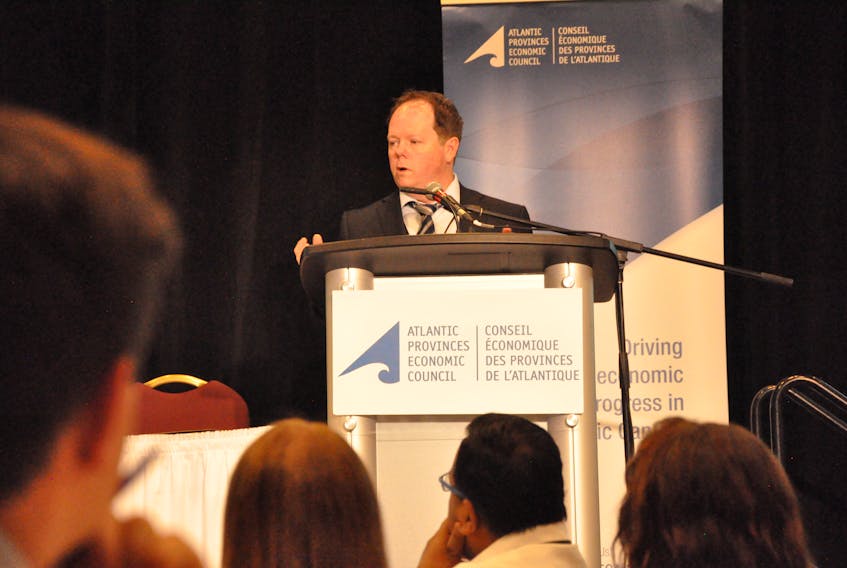The Atlantic Provinces Economic Council (APEC) is forecasting a continued slowdown in major project capital investment in Newfoundland and Labrador in 2018.
It’s a different story elsewhere in Atlantic Canada. Investment in Nova Scotia should remain relatively flat, whereas both New Brunswick and Prince Edward Island are expected to see investment grow by 10 per cent and 23 per cent, respectively, over last year.
The decline in this province — due largely to less money being spent on the construction of the Muskrat Falls hydroelectric project and a slight drop in mining spending — will result in total investment across the region falling eight per cent lower than 2017 levels.
“There is a big drop again this year, down 19 per cent to $5 billion and the major factor there is the slowing of spending at Muskrat,” Brannon told APEC members at its 11th annual major projects event in St. John’s on Wednesday,
Brannon does say, however, that the end of the slowdown is in sight, starting as early as 2019.
“Looking forward to next year, about seven per cent decline in 2019, with Muskrat Falls again slowing, but balanced a little bit by better offshore exploration activity and a peaking of activity on the West White Rose project and a bit of mining support as well.”
While economic factors such as commodity prices and exchange rates have always and will always play a role in a given company’s decision to invest in Atlantic Canada, policy factors are starting to play a bigger part, he said.
Major U.S. corporate tax cuts have made Newfoundland and Labrador’s neighbours to the south just as attractive for investment, and the uncertainty around NAFTA isn’t helping. Carbon pricing legislation and major changes to environmental assessment processes have also resulted in some companies keeping the chequebooks tucked away for the time being.
“This level of uncertainty due to those competitiveness concerns, potential trade barriers and environmental regulations are likely to dampen investments,” Brannon said. “We’re hearing from companies that they are holding back on some because they’re trying to understand all this and they need better clarity in terms of where it’s going moving forward so they can make those investment decisions.”
Oil and gas
It should come as no surprise that the turnaround in this province will be fuelled by investment in the province’s offshore oil and gas sector, with roughly $2 billion being spent in 2018. That figure accounts for 40 per cent of total spending, but down about eight per cent due to the Hebron project coming on stream.
Leading the way, also not surprisingly, is Husky Energy, which will make significant investments in West White Rose project work that will begin in earnest this year, much of it happening in Argentia.
“Husky’s also very busy right now with some infill wells in 2018 and 2019 that will help offset some of the natural declines at the White Rose field, and Husky is expecting to spend $750 million to $775 million in the Atlantic offshore this year, so that’s an increase over their recent levels,” Brannon reported, pointing to further long-term potential at the Husky-dominant North West White Rose field discovered in 2017 and the A24 field discovery earlier this year.
APEC is forecasting “quieter” exploration in 2018, but notes that recent calls for bids have been very successful with over $3 billion in work commitments in the years to come and a record 18 parcels available in the next call for bids.
Helping the offshore along is a somewhat unexpected growth in the price of oil, with Brent crude averaging US$70 per barrel over the first five months of 2018 compared to an average price of US$44 in 2016.
“There’s still a lot of volatility in the system and it’s not really clear that these prices will hold,” Brannon said. “Most forecasts don’t anticipate $70 per barrel this year, but it’s definitely a positive trend at the moment.”
Mining
Iron ore has also seen its average price per tonne increase over the first quarter and a bit of 2018, climbing to US$71. In 2016, the average price was $58.
“Nickel has also seen some strong gains, up 36 per cent in the first five months of this year compared to last year, which is a positive sign for the Vale underground project in Labrador,” Brannon said.
Overall, however, APEC’s baseline forecast for the province’s mining sector remains fairly weak, with most prospects still a year or two out.
Those include the aforementioned Vale underground mine project — previously estimated at US$1.9 billion — and the Kami iron ore project in Labrador West — valued at approximately $1 billion.
Gold mining operations in parts of the province will continue to benefit from strong gold prices.
Exploration work this year is valued at $38 million, slightly above last year and indicative that investment is moving in the right direction.
Capital in the capital
While there’s decline on the whole in the province, the greater St. John’s area will see an increase of 15 per cent in 2018.
The biggest factor, Brannon said, is Memorial University’s new core science building on Prince Philip Drive.
“That’s a big project that’s peaking in activity into this year,” Brannon said. “Some other projects at MUN (include) the renovations to the Battery as well as an animal resource centre, a $36-million project.”
Other major projects in the area fuelling growth are the continued redevelopment and expansion of St. John’s International Airport and the Avalon Mall; Walmart’s plan to convert two locations into Super Centres; construction on the Shoppes at Galway; and a series of new hotel projects, including the new Hilton Garden Inn in the downtown core.
Public sector
APEC is forecasting that public-sector spending in Newfoundland and Labrador will stabilize in 2018 following three years of steady and significant decline following the economic boom of the early 2010s.
That said, Brannon said there’s still $710 million from the three levels of government, led primarily by federal infrastructure programs that are matched by provincial and municipal governments.
Among the major projects are a $39-million upgrade to the wastewater facility in Gander; $77 million for roads and additional funding for the Trans-Labrador Highway; $43 million for schools; and $45 million for health-care facilities, such as the new long-term care facility in Corner Brook that is being partially funded through a design, build, finance, maintain relationship with the private sector.
Brannon said those kind of relationships will be key in the future.
“In the medium term, it gives the province some flexibility to redistribute some of its capital spending in other areas, especially looking at schools, where funding has declined in recent years.”
Twitter: kennoliver79









